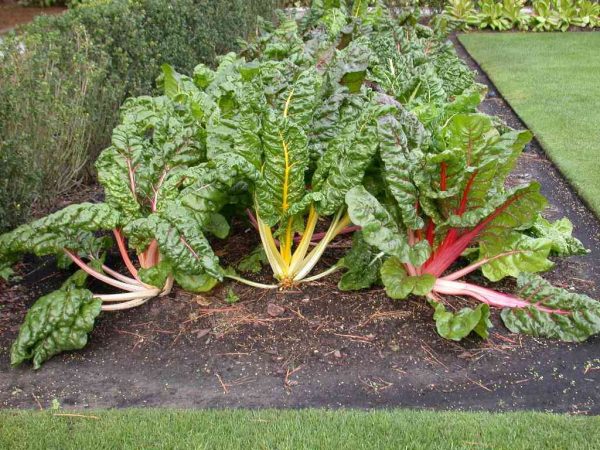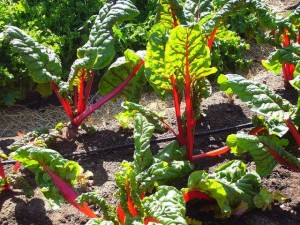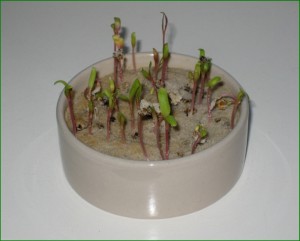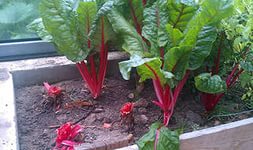What is chard?
Chard, or Swiss chard, is a popular type of leaf salad in Mediterranean countries, which is often compared to spinach, as it contains many nutrients, vitamins and minerals, while remaining an extremely low-calorie and tasty product.

This is what chard looks like
Why grow chard if you grow regular beets in your garden?
The same question can be asked about cabbage: why grow Chinese or cauliflower cabbage if white cabbage is more familiar to us? The more vegetables on the table, the richer the diet. The same chard (leaf beets, spinach beets) surpasses table beets in the content of vitamins, calcium salts, phosphorus, and iron. The leaves can be used in much the same way as white cabbage, and the stalks can be used like cauliflower (eaten after hot processing).
If you try to find out what is more primary - chard or root beet, it turns out that the latter is the result of hybridization of chard with wild beet species.
How to Grow Chard
Growing Swiss chard is not difficult and is in many ways similar to growing table beets.
Chard is a cold-resistant plant: its seeds germinate already at a temperature of 6-7 degrees. The seedlings can withstand temperatures down to minus 2 degrees. Along with April sowing, mid-summer sowing is practiced - for delicate autumn greenery. Pre-winter sowing is also possible - on already frozen soil in previously prepared seed furrows. Seeds are planted to a depth of 2 cm.
Where to grow. Can grow in almost any soil. But in moist, fertile conditions it develops a beautiful rosette. Therefore, it is better to grow it after crops for which organic matter was added, or add it when preparing a bed to a bucket of well-ripened compost or humus per square meter. m.
When to sow seeds. Chard is sown when the soil at a depth of 3-4 cm warms up to 7...8°C, i.e. practically together with planting potatoes. At earlier dates, the crops must be covered with film. We should also not forget that when sowing early, low air temperatures can cause bolting of plants.
Shoots appear in 10-15 days.Since chard seeds, like beets, are a cluster containing 2 or more seeds enclosed in a common shell, its crops usually require severe thinning.
The emerging seedlings are hilled up almost immediately - for the stability of the plants. At the stage of 2-3 true leaves, the seedlings are thinned out. After two weeks, they are thinned out again: varieties of petiole chard should be spaced 35-40 cm apart from each other, and varieties of leaf chard by 20-25 cm. In thickened crops, growth deteriorates and yields decrease.
Growing chard through seedlings. To obtain early greenery, Swiss chard is grown through seedlings. To do this, in March-April, the seeds are sown in individual pots. At the age of 30-35 days, the plants are planted in a permanent place according to the specified scheme.
Plant care. Chard will grow without special care, but to ensure that its leaves are large, juicy, and tender (you can “hide” stuffing for cabbage rolls in these), it is regularly watered during cultivation and occasionally fed with weak solutions of mineral fertilizers (0.5 teaspoon complex fertilizer per 10 liters of water, consumption - per sq. m). Use nitrogen fertilizers only at the beginning of growth to avoid the accumulation of nitrates in the leaves.
You can cut off the leaves little by little (“pinch” like sorrel), starting with the outer ones. After pruning, the remaining leaves grow even better. No more than a quarter of the leaves are cut from the plant at a time, making sure to leave the growth point intact. After cutting, the leaves quickly wither, so they are immediately placed loosely in plastic bags and stored in the refrigerator.
Strong plants can be left in the garden bed in winter, covered with soil and covered with compost and leaves before frost.Chard tolerates favorable winters well and begins to grow back very early in the spring, because by nature it is a biennial.
Growing chard on a windowsill
In the autumn garden you can dig up roots for later growing them on the windowsill. It is better to choose plants with the thickest main suction roots.
They are planted close to each other, sprinkled with a soil mixture (turf soil, humus, sand - 1: 1: 0.5), while leaving the growing point open. The planted plants are kept for a week and a half at a temperature of 8-10 degrees.
In such a microclimate, plants quickly take root in a new place and then, exposed to a warmer room, begin to grow actively. The most favorable temperature for growing chard is 17 - 20 degrees. Windows of south-eastern and south-western orientation, glazed loggias, and verandas are suitable for it. Water at room temperature. Twice a month they feed with organic-mineral fertilizer.
Beneficial properties of chard
At first, leaf beet was appreciated as a medicinal plant, and only then it began to be grown as a vegetable crop. Chard is useful for people suffering from obesity, diabetes, kidney stones, and anemia. This plant is in second place after spinach in the ranking of the healthiest vegetables.
- Chard is useful for diabetes, obesity, anemia, after serious illnesses and also for spring vitamin deficiency.
- Just 1 serving (200 grams) can provide 60% of the daily minimum of magnesium, the most important mineral in the body.
- Research has shown that chard helps regenerate pancreatic cells.
- It has hepatoprotective properties and removes toxins from the body.
- Strengthens the immune system.
- Chard contains a record amount of vitamin K, which, like calcium and magnesium, is necessary for the formation of bone tissue.
- Improves the functioning of the cardiovascular system.
And that’s not all the beneficial properties of chard. One of the main ones is a continuous conveyor of vitamin leaves from spring to autumn, and if you dig up plants for forcing, even in winter.
The leaves can be added to fresh vegetable salads, soups, cabbage rolls can be made from them, etc. Chard is used to decorate cold appetizers. It fulfills this role no worse than traditional lettuce leaves. The petioles are boiled, fried, stewed. Botvinya is prepared from red chard.
To the listed advantages you can add the decorative nature of plants: a mixture of varieties with differently colored (green, silver-white, yellow, orange, crimson, red-violet) petioles is a decoration not only for the vegetable garden; chard can even be grown in a flower garden.
Chard varieties
Scarlet - resistant to coloration. The first collection of leaves can be carried out 38-42 days after emergence; 80-90 days pass before final harvesting. The rosette of leaves is spreading, 60 cm high. The leaves are violet-green, slightly bubbly, large. The petioles are crimson-red, up to 27 cm long. The yield of leaves and petioles in open ground reaches 3-5.5 kg per 1 m2, when grown in a greenhouse and hotbeds - up to 10 kg.
Green - very good for winter sowing, in this case the period from sowing to leaf regrowth is 180-200 days, from germination to harvesting 90-120 days. The rosette of leaves is semi-vertical. Leaves are 60 cm long, green, glossy, without anthocyanin, medium vesicular. Petioles 25 cm long.
Emerald — growing time from germination to harvest is 60 days.The rosette of leaves is vertical, compact, 45 cm high. The leaves are medium-sized, light green, medium-vesicular. Petioles are about 30 cm long, wide, green, slightly curved, juicy. The weight of petioles from one plant is about 1 kg.
Gorgeous — growing time from germination to harvest is 60 days. The rosette is vertical, compact, the leaves are large, dark green, with a wavy surface. Petioles are 30-40 cm long, bright red, slightly curved, juicy. The weight of petioles per plant is 800-900 g.





 (4 ratings, average: 4,75 out of 5)
(4 ratings, average: 4,75 out of 5) CUCUMBERS NEVER GET SICK, I'VE BEEN USING ONLY THIS FOR 40 YEARS! I SHARE A SECRET WITH YOU, CUCUMBERS ARE LIKE THE PICTURE!
CUCUMBERS NEVER GET SICK, I'VE BEEN USING ONLY THIS FOR 40 YEARS! I SHARE A SECRET WITH YOU, CUCUMBERS ARE LIKE THE PICTURE! You can dig a bucket of potatoes from each bush. Do you think these are fairy tales? Watch the video
You can dig a bucket of potatoes from each bush. Do you think these are fairy tales? Watch the video
 How our fellow gardeners work in Korea. There is a lot to learn and just fun to watch.
How our fellow gardeners work in Korea. There is a lot to learn and just fun to watch. Eye trainer. The author claims that with daily viewing, vision is restored. They don't charge money for views.
Eye trainer. The author claims that with daily viewing, vision is restored. They don't charge money for views. A 3-ingredient cake recipe in 30 minutes is better than Napoleon. Simple and very tasty.
A 3-ingredient cake recipe in 30 minutes is better than Napoleon. Simple and very tasty. Therapeutic exercises for cervical osteochondrosis. A complete set of exercises.
Therapeutic exercises for cervical osteochondrosis. A complete set of exercises. Which indoor plants match your zodiac sign?
Which indoor plants match your zodiac sign? What about them? Excursion to German dachas.
What about them? Excursion to German dachas.
Since chard contains vitamin K in larger quantities than the body needs, it is important to consume it in moderation. After all, even beneficial vitamins can cause harm if the correct dosage is not followed.
And what delicious cabbage rolls you make from chard! Thank you, interesting article.